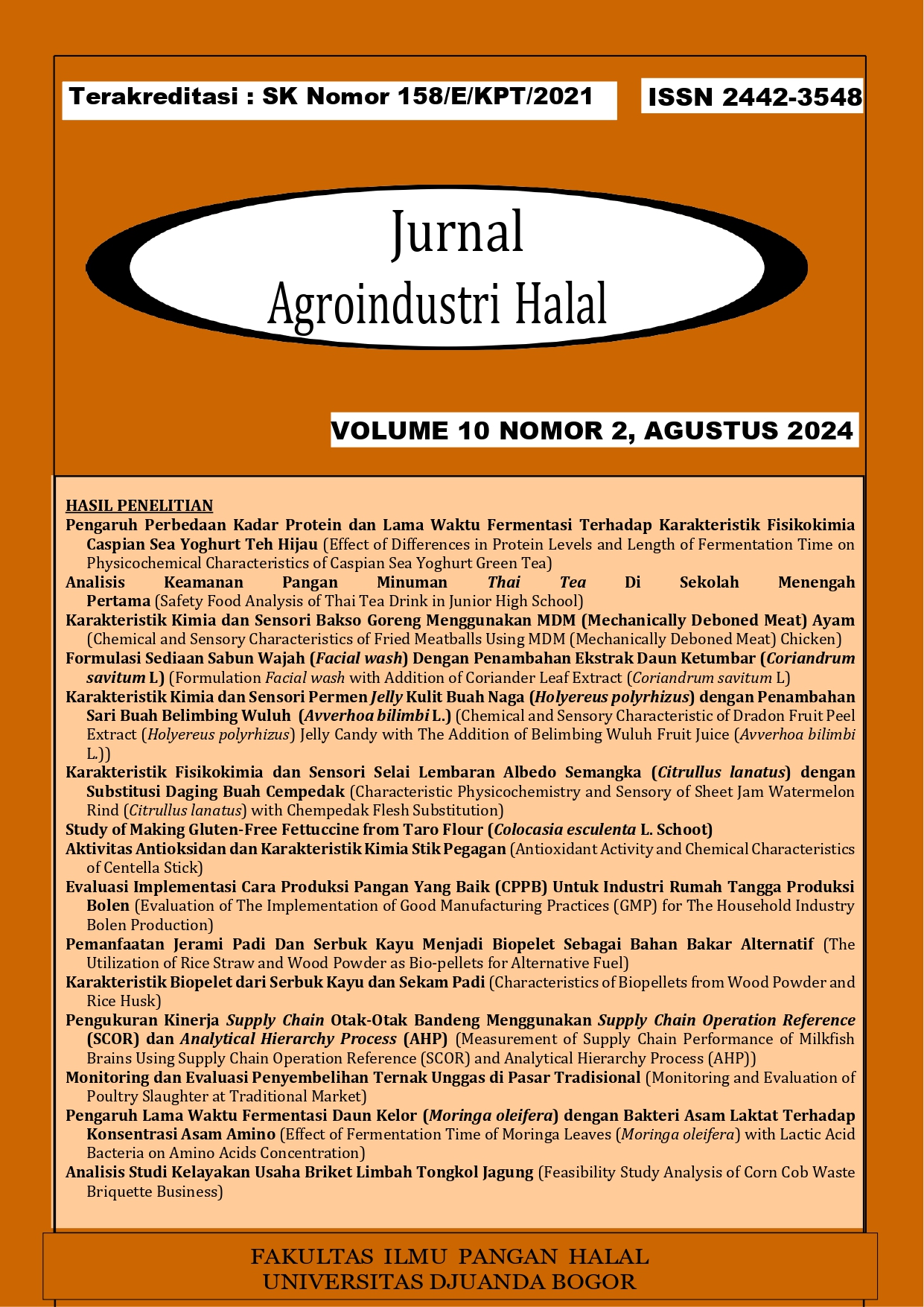Study of Making Gluten-Free Fettuccine from Taro Flour (Colocasia esculenta L. Schoot)
DOI:
https://doi.org/10.30997/jah.v10i2.10591Keywords:
fettuccine, gluten free, organoleptic, taro flour, yolkAbstract
We often encounter fettuccine pasta in cafes and restaurants, usually made from wheat flour
as the main ingredient. Wheat flour is a food ingredient that contains gluten, which is a protein
compound from cereals that cause allergies and irritate the small intestine and can also cause
celiac (autoimmune) disease in certain people. Several studies have substituted wheat flour
for making fettuccine with non-gluten taro flour. The formula obtained is still a mixture of taro
flour and wheat flour. This research used 100% pure taro flour with additional ingredients of
two types of egg yolk, namely chicken egg yolk and duck egg yolk. This research aimed to
determine the organoleptic results of fettuccine from 100% taro flour based on the
formulation using the type of egg yolk and boiling time. This study used a completely
randomized trial (CRD) design with four treatments and two repetitions. The types of
treatment in this study were the use of duck eggs with a boiling time of 35 seconds, the use of
boiled duck eggs for 1 minute, the use of boiled chicken eggs for 35 seconds, and the use of
boiled chicken eggs for 1 minute. The research results showed that fettuccine was successfully
made using 100% taro flour without being mixed with wheat, using additional egg yolk as a
binder. A perfect assessment was obtained from the expert panelists for the duck egg yolk
formula boiling for 1 minute. The type of egg yolk and boiling time affect the sample in terms
of taste, color, and texture, but not aroma.
References
Andrianto, R. (2013). Kandungan Albumin dan Organoleptik Telur Ayam Leghorn dan Ayam Kampung Setelah Penambahan Ekstrak Bawang Putih (Allium Sativum) dengan Konsentrasi yang Berbeda. Skripsi. Jurusan Pendidikan Biologi. FKIP. Universitas Muhammadiyah Surakarta.
Badan Pusat Statistik. (2018). Banyaknya RM Makan, Restauran dan Cafe Menurut Kabupaten/Kota 2017-2018. Diakses pada tanggal 02 April 2022. https://jabar.bps.go.id/indicator/16/217/1/banyaknya-rm-makan-restauran-dan-cafe-menurut-kabupaten-kota.html.
Goi, M. (2017). Penanganan Gizi pada Celiac Disease. Journal Health and Nutritions. Vol. 3, 2.
Luckyanto. (2017). Pembuatan Pasta Fettuccine Dengan Subtitusi Tepung Talas Sebagai Pengganti Tepung Terigu. Sekolah Tinggi Pariwisata Trisakti.
Statistik, B. P. (2018). Banyaknya RM Makan, Restauran dan Cafe Menurut Kabupaten/Kota 2017-2018. Badan Pusat Statistik. https://jabar.bps.go.id/indicator/16/217/1/banyaknya-rm-makan-restauran-dan-cafe-menurut-kabupaten-kota.html.
Ningrum, L. (2017). How The Panelists Votes Chicken Ballotine With Analog Chicken Turkey and Duck. International Journal of Innovative Science and Research Technology. Volume 2, Issue 4, April-2017. ISSN No: - 2165. www.ijisrt.com.
Rahardjo, S., Soeswoyo, D. M., Simanihuruk, M., & Kusumawardhani, Y. (2022). STUDY ON THE QUALITY OF FOOD AND BEVERAGE PRODUCTS IN SUKAJADI VILLAGE, BOGOR. Jurnal Cakrawala Ilmiah, 1(11), 3057-3068.Rangkuti, F. (2011). Riset Pemasaran. Jakarta: PT. Gramedia.
Risti, Y. & Arintia, R. (2013). Pengaruh Penambahan Telur terhadap Kadar Protein, Serat, Tingkat Kekenyalan dan Penerimaan Mie Basah Bebas Gluten Berbahan Baku Tepung Komposit (Tepung Komposit : Tepung Mocaf, Tapioka dan Maizena). Journal of Nutrition College, Volume 2, Nomor 4, Tahun 2013, Halaman 696-703.
Saputra , F., Hartiati, A., & Admadi, B. (2016). Karakteristik Mutu Pati Ubi Talas (Colocasia esculenta) pada Perbandingan Air dengan Hancuran Ubi Talas dan Konsentrasi Natrium Metabisulfit. Jurnal Rekayasa dan Manajemen Agroindustri, 62-71.
Suyanti. (2010). Membuat Mie Sehat . Jakarta : Penebar Sadaya.
Widyastuti, E., Claudia, E., & Ningtyas. (2015). Karakteristik Biskuit Berbasis Tepung Ubi Jalar Oranye (Ipomoea batatas L.), Tepung Jagung (Zea mays) Fermentasi, dan Konsentrasi Kuning Telur. Jurnal Teknologi Pertanian. Vol. 16 No. 1 [April 2015] 9-20.
Downloads
Published
How to Cite
Issue
Section
License
Copyright (c) 2024 Sekti Rahardjo, Aminudin, Saleha, Tatik Sriwulandari, Nisa Rahmaniyah Utami

This work is licensed under a Creative Commons Attribution-ShareAlike 4.0 International License.
Authors who publish with Jurnal Agroindustri Halal agree to the following terms:
- Authors retain copyright and grant the journal right of first publication with the work simultaneously licensed under a Creative Commons Attribution 4.0 International License that allows others to share the work with an acknowledgement of the work's authorship and initial publication in Jurnal Agroindustri Halal.
- Authors are able to enter into separate, additional contractual arrangements for the non-exclusive distribution of the journal's published version of the work (e.g., post it to an institutional repository or publish it in a book), with an acknowledgement of its initial publication in Jurnal Agroindustri Halal.
- Authors are permitted and encouraged to post their work online (e.g., in institutional repositories or on their website) prior to and during the submission process, as it can lead to productive exchanges, as well as earlier and greater citation of published work









